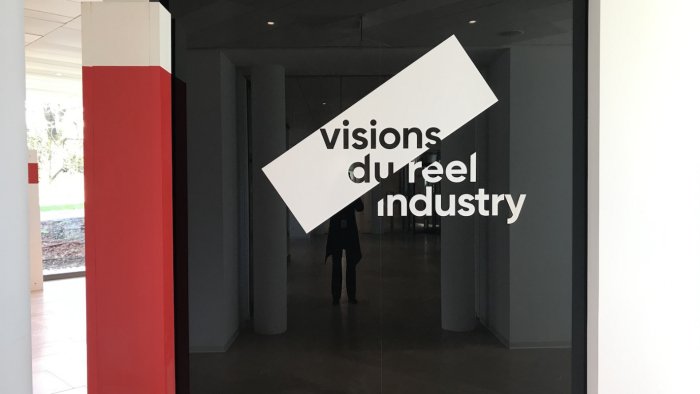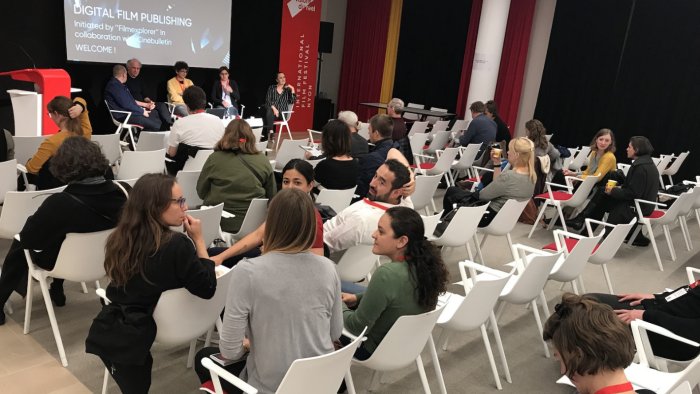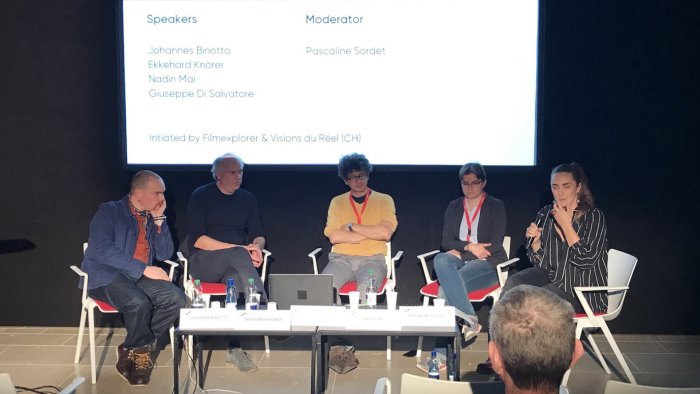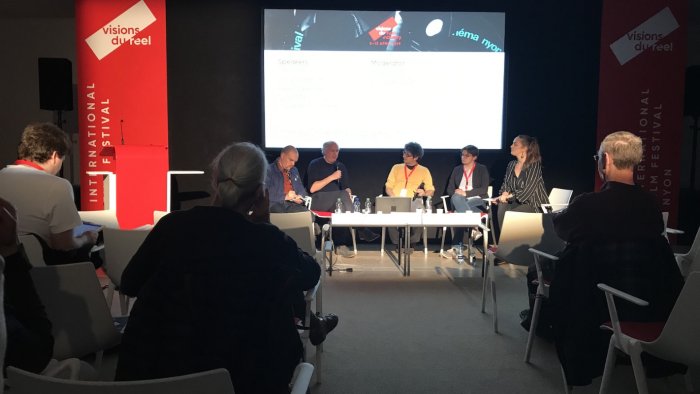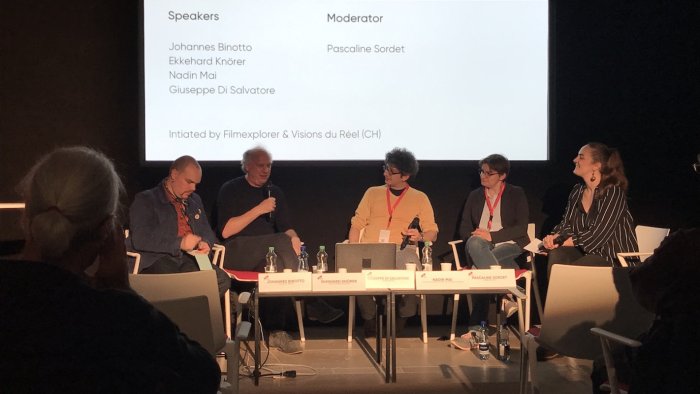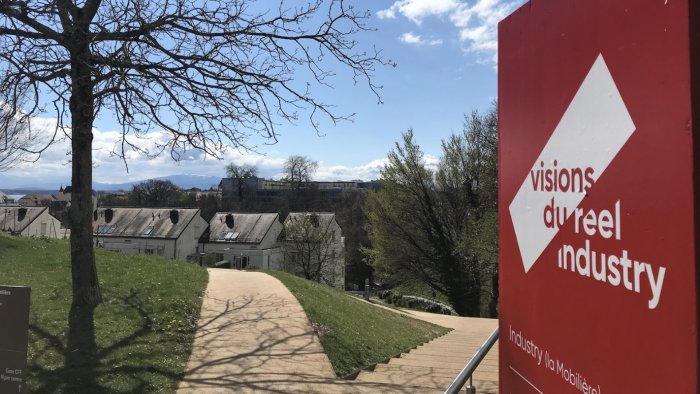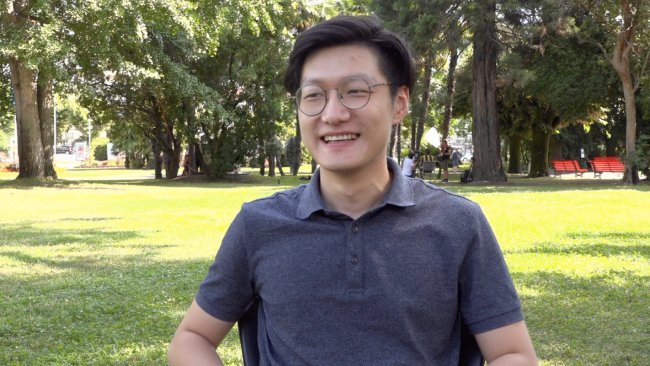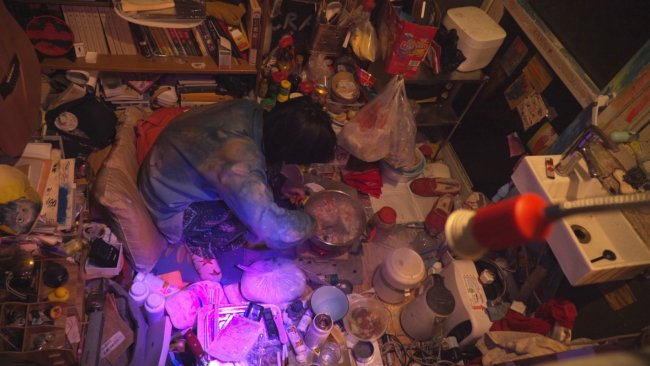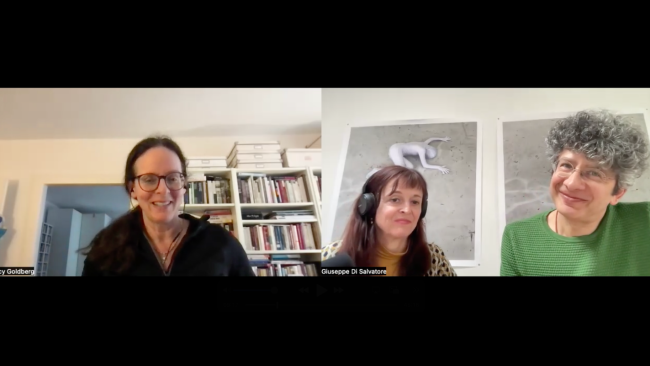Critical Clicks: The Challenges of Digital Film Publishing
[...] Eine Selektion findet also in doppelter Hinsicht statt – bei den Filmen und beim Publikum. Wobei der Aufbau der Community zwangsläufig beim persönlichen Netzwerk beginnt, wie Mitbegründer und Co-Chefredaktor Giuseppe Di Salvatore bemerkte. Er sieht die Chance des digitalen Publizierens darin, dass sich die Nische nach und nach auf eine globale Ebene ausweiten kann.
[...] Johannes Binotto präsentierte mit seinem Video-Essay ebenfalls ein webspezifisches Format, betonte aber gleichzeitig, wie wenig die Spezifität des Digitalen – nämlich seine Multimedialität – in der Filmkritik bisher genutzt werde.
[...] Die textbasierte Filmrezeption sei eine Kunstform in sich, ergänzte Nadin Mai, bedauerte jedoch gleichzeitig, dass diese traditionelle Form heute auch in der Lehre noch zu sehr dominiere.
[...] «Wir wissen alle, wie böse Facebook ist», meinte Ekkehard Knörer. «Doch die Idee dahinter ist genial. Wer könnte ein besserer Aggregator von relevanten Informationen für mich sein als diejenigen Menschen, denen ich vertraue?»
Podcast
Panel at Visions du Réel | Critical Clicks: The Challenges of Digital Film Publishing
Find a list of all our Podcasts here.
FILMEXPLORER:
If we want to use the resources that digital publishing has to offer, we must rethink the form of moving image reviews to include audio and video media as well, not only text. This means learning new languages, learning about new forms of communication and creating a more complex content which can better approach films as an object of discussion. The film review becomes an expanded experience of the film. If we wish to keep our content active, to make sure it is seen over time, we should use more than one outlet for our content: digital outlets (social media, shared content, etc.) and physical outlets (festival and cinema discussions). Furthermore, the biggest challenge in the digital era will be to use these outlets together, as an ensemble, in order to defend our long, in-depth content, wherever it may appear. One content, several outlets: this is the very definition of cross-media.
True to their “avant-garde” identity, Filmexplorer and Visions du Réel are collaborating with Cinébulletin in order to foster an open discussion on the subject. With the help of experienced professionals, this discussion aims to bring an urgent reflection on digital publishing to light. In a world where moving images are in hyperproduction, the critical reception and discussions of films is more important than ever.
*
JACQUELINE BECK:
Im Herbst 2017 hat Filmexplorer eine Diskussion über die veränderte Wahrnehmung des bewegten Bildes im digitalen Raum lanciert. Wie orientieren wir uns angesichts der Inflation von online verfügbaren Informationen und Bildern? Und in welcher Form ist eine kritische Auseinandersetzung mit Inhalten beim gegenwärtig anhaltenden und tiefgreifenden Medienwandel möglich?
«Das Herstellen von Relevanz ist eine Kunst», sagte Mercedes Bunz, eine der Gesprächspartnerinnen im Forum zu «Digital Criticism», und weiter: «Öffentlichkeit ist nicht einfach da, man stellt sie her.» Das kann man auch im Hinblick auf die Veranstaltung «Critical Clicks» am Festival Visions du Réel in Nyon bestätigen. Für eine Weiterführung der Diskussion im analogen Raum hatte Filmexplorer in den vergangenen eineinhalb Jahren verschiedentlich geweibelt, hatte mit diversen Veranstaltern gesprochen und persönliche Einladungen verschickt. Doch schwach blieb der «Industry Talk» von den Protagonisten der Filmpublizistik besucht. Zu eingespannt in ihre täglichen Aufgaben schienen die Verantwortlichen zu sein.
«Befinden wir uns in einer Zeit der „Hyperproduktion von Diskurs“?», wie Moderatorin Pascaline Sordet fragte. «Wir glauben, dass wir uns nicht zu engagieren brauchen», beklagte sich der Kultur- und Medienwissenschaftler Johannes Binotto, der u. a. für das Filmbulletin schreibt. «Zumindest im deutschsprachigen Raum ist der Diskurs um Filmästhetik und Filmpolitik nicht sehr weit gediehen.» So ging es an der Podiumsdiskussion auch in erster Linie um eine Zustandsanalyse: Wie bewegen sich die Publizistinnen und Publizisten im digitalen Raum? Wie erreichen sie ein interessiertes Publikum?
Die Filmwissenschaftlerin Nadin Mai hat mit ihrem Blog «The Art(s) of Slow Cinema» eine Nische geschaffen, die immerhin 10000 Besucherinnen und Besucher pro Monat anlockt. Ihre Beiträge beschreibt sie als «geradeheraus», aus einer persönlichen, femininen Perspektive geschrieben – so etabliert sie eine Autorschaft, die sich nicht hinter vermeintlicher Objektivität oder Wissenschaftlichkeit versteckt.
Auch Filmexplorer spricht mit seiner Film-Auswahl explizit ein Nischenpublikum an, indem besonders gewagte und experimentelle Formen besprochen werden. Eine Selektion findet also in doppelter Hinsicht statt – bei den Filmen und beim Publikum. Wobei der Aufbau der Community zwangsläufig beim persönlichen Netzwerk beginnt, wie Mitbegründer und Co-Chefredaktor Giuseppe Di Salvatore bemerkte. Er sieht die Chance des digitalen Publizierens darin, dass sich die Nische nach und nach auf eine globale Ebene ausweiten kann.
Als «fast and dirty» bezeichnete Ekkehard Knörer die Aktivitäten des Cargo-Magazins im Internet – bereits vor 10 Jahren hatte man ein eigenes, Twitter-ähnliches Format für die Festival-Berichterstattung auf der Website eingeführt. Johannes Binotto präsentierte mit seinem Video-Essay ebenfalls ein webspezifisches Format, betonte aber gleichzeitig, wie wenig die Spezifität des Digitalen – nämlich seine Multimedialität – in der Filmkritik bisher genutzt werde.
So war es denn auch bezeichnend, dass von den am Panel vertretenen Medien nur Filmexplorer ausschliesslich online unterwegs ist. Wenn auch alle mit den multimedialen Möglichkeiten experimentieren (etwa indem sie wie Mai Film-Stills einsetzen, wenn Worte für das Beschriebene nicht ausreichen, oder Video-Interviews, wie Filmexplorer), so steht bei den Besprechungen doch eindeutig der Text im Vordergrund.
«Weshalb sind Filmkritiker denn so textfixiert?», wollte Pascaline Sordet wissen, und bekam von Giuseppe Di Salvatore die einleuchtende wie simple Antwort: «Text ist der beste Weg, um einen intelligenten Gedanken auf eine schnelle Art und Weise zu kommunizieren.» Die textbasierte Filmrezeption sei eine Kunstform in sich, ergänzte Nadin Mai, bedauerte jedoch gleichzeitig, dass diese traditionelle Form heute auch in der Lehre noch zu sehr dominiere. Anders sah dies Johannes Binotto: «Das Denken in Texten ist auch in Video-Essays interessanter.» Er berief sich auf Werner Herzog, den Maître des diesjährigen Festivals, der dem Nachwuchs geraten hatte: «Lesen, lesen, lesen!»
Doch wie viel Text wird online überhaupt noch gelesen? Diese grosse Frage entzündet sich nicht zuletzt am Einsatz von Social Media. Findet auf Plattformen wie Facebook überhaupt noch eine Auseinandersetzung mit Inhalten statt? Oder geht es in erster Linie um ein gegenseitiges Schulterklopfen in Form von Likes? «Wir wissen alle, wie böse Facebook ist», meinte Ekkehard Knörer. «Doch die Idee dahinter ist genial. Wer könnte ein besserer Aggregator von relevanten Informationen für mich sein als diejenigen Menschen, denen ich vertraue?»
Mit Mercedes Bunz könnte man sagen: Eine Technologie ist per se weder gut noch schlecht, sondern abhängig davon, wie wir sie nutzen. Bunz sieht den Kritiker heute vermehrt in der Rolle eines Kurators, der auswählt und einordnet. In diesem Sinne glaubt auch Giuseppe Di Salvatore, dass es möglich ist, ein kritisches Profil auf Social Media zu etablieren. In erster Linie gehe es aber darum, Inhalte zu zitieren, die anderswo publiziert würden. Auf den springenden Punkt dabei machte Johannes Binotto aufmerksam: «Das Feld, auf dem der Inhalt wachsen kann, ist verschwunden.»
Will heissen: Für Online-Publikationen gibt es nach wie vor kein nachhaltiges Finanzierungsmodell. Alle Teilnehmenden am Panel gaben zu Protokoll, dass sie mit ihren filmpublizistischen Tätigkeiten im Netz nichts verdienten. «Ohne Leidenschaft kannst du so etwas nicht machen», ist Nadin Mai überzeugt. Doch langfristig ernährt sich niemand von Luft und Liebe. Wenn eine Gesellschaft eine lebendige Filmkultur will, muss sie auch bereit sein, für deren Einordnung zu bezahlen. Wohin soll ich sonst bitte gucken?
*
NADIN MAI:
Digital opportunities
Even though there seem to be more and more publishing opportunities with a great deal of independent publishers available to writers, it has not necessarily become easier to publish books, book chapters, or journal articles. We live in contradictory times. Publishing is a business. Perhaps more so than ever before, submissions are not only selected because of their quality but also because of their potential profitability. A book on Marvel will always sell better than a publication on a niche director, whose films are rarely seen on a big screen. Whatever promises to sell best will get an advantage in the selection process. What sells are names, and known and popular subjects. Of course, the publishing landscape is not as black-and-white as I describe it here, and yet, there is a reason for the growing number of people who look towards digital publishing.
For over six years now, I have written about Slow Cinema, a niche subject in film criticism and in academic Film Studies. Over time, The Art(s) of Slow Cinema has become the largest database on the subject. As of yet, I have only a single print publication to my name, but have had more opportunities via digital outlets to contribute articles or opinion pieces. From the start, Slow Cinema has been a niche, albeit global phenomenon. Early writing on slow films gave rise to certain connotations that were hard to shake off later. Boring films that reacted to modernity’s speed – any publisher would agree that it would be a hard sell. Slow-film directors and producers are aware of this problem. Nevertheless, Slow Cinema couldn’t be ignored for long because it became an arthouse stronghold in the 21st century.
If the cinematic output of Slow Cinema is predominantly male, then print publications on it are even more so. In general, writing on slow films has an exclusively Western male voice. Digital publishing offers female voices an easier environment to emerge in than print media, which often rely on established male voices as their selling points. The first edited collection on Slow Cinema is a case in point, ignoring female writers who have done extensive research on the subject but whose proposals were rejected, and then replaced by chapters written by more well-known male academics despite their not having the same experience in the field. I myself had the experience of having been asked to submit a book proposal because a book on Slow Cinema was of interest to the publisher at the time. The proposal was rejected with the curious argument that the subject wouldn’t fit into the publisher’s portfolio… only for the project to be given to two male editors. This is one example among many that women writers deal with every day.
However, blogs such as The Art(s) of Slow Cinema are free of editorial constraints. It’s not about selling points. It is about the personal interests and passions of the writer. It is about quality content. Digital publishing allows writers to fill the gaps left open by traditional publishing: themes and subjects that we think are essential but which haven’t been covered in books or magazines; critiques of existing material but also of publishing methods; responses to current developments. Or simply put: it is a platform for creating alternative content.
Digital publishing can be an underground form of practicing (film) criticism. It can be a form of annotating existing material, all while putting more emphasis on verticality. Film criticism is often done horizontally. They scratch the surface, often summarise a film’s storyline, but give neither the reader nor the viewer much room for thought. Film criticism, if done horizontally, steers the reader into a specific direction of thought, just as many directors steer their viewers’ thoughts via their choice of narrative style, their use of specific aesthetics, etc. Digital publishing, like The Art(s) of Slow Cinema, can allow vertical, i.e. slow, film criticism to take place. I believe that certain films, in particular slow films, require an alternative form of film criticism. They need to be digested, need to work in the viewer’s mind before writing about them is even thinkable. Film festival reporting, which often demands traditional film journalists to write a critique immediately after seeing the film, can never reach the depth that an article reaches if it is mulled over for several days.
Paradoxically though, the idea of slow criticism arose with the fast, the digital, the ever-increasing flux of published content. It is the digital world that made speedy and often superficial surface content possible, but it is this same digital world that can take the speed out of publishing, and that can give writers the time and space they need in order to explore a film in depth. From this perspective, digital publishing is clearly an excellent opportunity. It is a chance for niche subjects, and it is a chance for female writers, as well as for writers from different social and ethnic backgrounds. It is a way to create a voice, which is not usually heard in traditional media.
*
GIUSEPPE DI SALVATORE:
A PLEDOYER FOR MEDIUM SPECIFICITY
The film as medium of the arts
The platform Filmexplorer was started three years ago with relatively classical content: predominantly critical texts on films and audio/video interviews with the filmmakers. It may sound paradoxical, but it is exactly what it seemed to be missing in the Swiss panorama of film publishing, at least in the field of art films or, more broadly speaking, of moving images between art and cinema. The exchanges with the filmmakers and the critical discussions of the filmic works, with a special attention paid to the formal aspects of films, are for us the expression of a serious and passionate attitude towards film as a medium of the arts, which today goes against the tide of using films as occasions to speak about broader journalistic themes. According to us, the orienting question for film criticism is: what is specifically filmic in a work of moving images? What pertains specifically to the medium of film?
Our objective has not only been the filling of a gap, in Switzerland, between (the miserable state of) film journalism and (the often esoteric and self-referential) academic publishing on film, but also of stressing the importance of selection and curation as a fundamental critical tool in an epoch of hyperproduction of films. Therefore, the films that we choose to discuss are also meant, when taken all together, to create a profile that represents our aesthetic identity as critical actors.
Digital medium specificity
Independently of these general objectives on film criticism, the most important question that occupied Filmexplorer concerns the interpretation of medium specificity, which is also the question: what does it mean to publish a piece of film criticism on an internet platform? This issue seemed particularly pressing to us, as we had the impression that the other platforms working in the same domain around us had, surprisingly, evaded this fundamental question.
Concerning the format of texts, for example, a tentative answer to the medium specificity question has been to push our contributors to put aside aspects such as the description of the film, for information and promotion are two journalistic tasks that are already abundantly present online. On the contrary, we encourage the contributor to focus on original ideas and take a position on a film, even putting forward their subjective perspective, insofar as it is supported with arguments. Even if the maximum length of 6000/7000 characters has emerged as an ideal limit for digital output, we remain quite flexible on the length of the critical text, in order to respect the different styles of writing and highlight our vision of the contributor as an author.
Concerning the format of the audio and video productions, we have tried to optimize the balance between low budget production and high quality product: in interviews, for example, attentive framing, good sound quality, and refined editing – together with an investment in professional equipment – are fundamental conditions for us. At the same time, we deliberately keep a very small crew, which moreover has to be quite flexible in its time schedule and be able to adapt to very different shooting locations. Better to exercise a multi-skill profile than be a victim of professionalism, which very often equals nothing more than a high budget multiplication of specialists without a true preoccupation with motivation and content orientation.
The question of the specificity of the digital medium pushes us to not only take seriously the specificity of the medium text, audio, video, etc. separately, but also to ask ourselves how we can coordinate the different media on one channel at their best; this is the question of multimedia specificity. In this respect, we soon realised that working with more than one medium at the same time is a complex task, whose realisation can easily become confusing and thus unsatisfying. An essay to articulate the platform with a more complex multimedia language was our experience with the Forum 2017, which had equally been the occasion to evaluate the costs of complex multimedia formats. With the expectation of a high quality critical product, the cost-benefit balance reveals that simpler formats like the old textual one are still far from being obsolete.
The question of the public
With accurate and effort-demanding work, a critical product cannot but be quite expensive. Now, even if the big question of financing the activity of criticism should imply a reflection on the role of public commitment (it is not here the time and place to discuss the topic of cultural politics, but just to mention that for the moment Filmexplorer survives thanks fundamentally to private subventions…) we believe that a safe way to approach the sustainability of critical enterprises is to include it in the question concerning the public of film criticism, which ideally would directly support the critical platforms. Now, from this point of view a conversion of the mind is necessary. In the field of cultural management, the reference to a general, indistinct, anonymous public is still dominant, and for cultural enterprises, the perspective of an indefinitely growing future, where they would possibly reach a public of millions of people. On the contrary, we are convinced that a platform like Filmexplorer must consciously address a very specific public – a motivated community – of cinephiles and people that have the time and interest to nourish their cultural curiosity. This public will remain always relatively small in number. However, this is not necessarily bad news for the sustainability of the project, if we think of another specificity of the digital medium, which is its ability to reach geographically isolated people that share the same interest or passion. The choice to use four languages – which actually comes spontaneously to Filmexplorer by simply relating to the particularity of the Swiss territory – allows us such a broad reach.
Power and limits of cross-media
But how can we reach a specific and not yet defined group of people? The question of the public becomes the question of creating a public; and the question of creating a public becomes the question of interpreting the specificity of cross-media, for the main instrument to create our own public is the use of social media and newsletters – without forgetting the importance of our participation in film events, from the active presence at film festivals to the discussions on film forums and the commitment in live mediation for films. Filmexplorer has found itself destined to use more than one channel, and the question of understanding the functioning of cross-media has emerged as key.
For the moment, our task has not been one of developing a specific critical language for each of the various channels that we use. We focus more on the coordination of different channels in a coherent way. More precisely, the way we use cross-media is hierarchically oriented to the critical content of the platform, whereas the social media and the newsletters are used as tools to communicate, create a community, and convey the attention of our public to the content of the platform. One risk of developing several critical languages for each channel would be that the place for communication (social media and newsletters) equals the place for criticism, thereby putting aside the importance of a slow and in-depth discussion, which can be satisfied only through a more complex support system like the platform. Therefore, we consider the question of cross-media as very important, but stress at the same time the specificity of the needs of criticism, which has also pushed us to take into consideration the limits of the potentialities of cross-media.
Still much work to do
One of the motivations to launch a round table at the festival Visions du Réel 2019 – Critical Clicks – and this space of “dialogue” on our platform is the awareness that there is still much work to do concerning the different aspects of medium specificity. This work will necessarily be tentative and experimental, insofar as we hardly recognize successful patterns in the domain of the cultural and critical content-oriented digital platforms.
Amongst our current objectives, we want to go deeper into the understanding and testing of multimedia specificity. We are investing right now in audio productions; we want to enhance the coordination of the different channels and better execute our cross-media activity; we want to commit ourselves even more to the creation of an international community of cinephiles and people that invest in their cultural formation and appreciate the film as a form of art.
Watch
More on the theme on FORUM 2017 - section "Room for Discussion: Critical Criticism of Moving Images"
Interventions of Michael Baute, Jacqueline Beck, Mercedes Bunz, Kevin B. Lee, Mattias Frei
Info
Critical Clicks: The Challenges of Digital Film Publishing | Filmexplorer | Industry Talk, Visions du Réel Nyon 2019
SPEAKERS:
Johannes Binotto – Cultural and media scientist | film critic, Filmbulletin | editor, RISS magazine – Switzerland
Ekkehard Knörer – Media scientist and film critic | co-editor, Cargo magazine, Merkur magazine – Germany
Nadin Mai – Founder of the Art of Slow Cinema platform | Tao Films VoD platform – France
Giuseppe Di Salvatore – Philosopher | co-founder and co-editor-in-chief, Filmexplorer platform – Switzerland
MODERATOR: Pascaline Sordet – Co-editor-in-chief, Cinébulletin – Switzerland
First published: April 27, 2019
